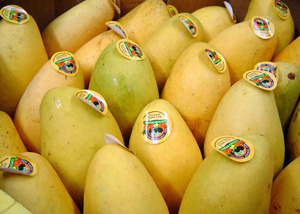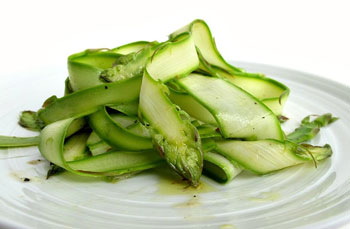For me nothing says "spring" more so than asparagus. As soon as the warm weather of early spring approaches, I start scouring the farmers' market for the first signs of asparagus. I'm always looking for the most slender green spears, ivory white ones, and even the dark purple-almost-black ones. I appreciate all types of asparagus.
I love asparagus cooked any which way except boiled—that's the reason I hated them so much as a kid because they I only ever had them boiled and overcooked. Even though they're not yet available at my most markets just yet, I've already begun cooking with asparagus. I'm just too eager to wait, so until they're available I won't mind the supermarket ones.
For this recipe I roast the asparagus to bring out their sweet taste. Alongside I also roast cherry tomatoes, which will become one of the many toppings for the dish. The dressing is a vinaigrette made from olives and lots of Dijon mustard. And finally the dish gets flourished with salty, tangy feta. This recipe is great as either an appetizer or a side dish.

 There are two things in my world that tell me spring is officially here. One, the call of the loons wake me from my morning slumber as they float on the river just outside my window. That just happened Wednesday morning. Two, the small juicy yellow-skinned mangoes are ready to purchase by the case at my favorite little Asian market in Fargo. Done. Spring is here.
There are two things in my world that tell me spring is officially here. One, the call of the loons wake me from my morning slumber as they float on the river just outside my window. That just happened Wednesday morning. Two, the small juicy yellow-skinned mangoes are ready to purchase by the case at my favorite little Asian market in Fargo. Done. Spring is here. Steamed, roasted or grilled—they're not the only ways to enjoy asparagus. Have you tried it raw? If you were to just bite in its pretty tough to eat. But that's where your vegetable shaver comes in. With it you can create thin ribbons of asparagus that are ready to eat—all without cooking.
Steamed, roasted or grilled—they're not the only ways to enjoy asparagus. Have you tried it raw? If you were to just bite in its pretty tough to eat. But that's where your vegetable shaver comes in. With it you can create thin ribbons of asparagus that are ready to eat—all without cooking. A pile of freshly cut rhubarb stalks appeared at our back door last week, courtesy of our neighbor Ralph. This is one of the strange and wonderful things about living on the Vineyard: People are in the habit of sharing…without much fuss or fanfare. Stuff just shows up, unbidden but much appreciated. In the short time we’ve been living in the farmhouse, we’ve been the grateful recipients of beach plum jelly, wild cherry jam, honey, eggs, lobsters, codfish, sweet potatoes, pickles, warm bread and kale soup, to name a few things.
A pile of freshly cut rhubarb stalks appeared at our back door last week, courtesy of our neighbor Ralph. This is one of the strange and wonderful things about living on the Vineyard: People are in the habit of sharing…without much fuss or fanfare. Stuff just shows up, unbidden but much appreciated. In the short time we’ve been living in the farmhouse, we’ve been the grateful recipients of beach plum jelly, wild cherry jam, honey, eggs, lobsters, codfish, sweet potatoes, pickles, warm bread and kale soup, to name a few things. Well, I am embarrassed to admit that I got overwhelmed in Whole Foods the other day. Here I am a Food Professional (whatever that is), and the sheer abundance of goodies in the store was just too much for me. Granted, it was a quick stop—I only had 10 minutes to troll the store, as I was on my way to a book signing at
Well, I am embarrassed to admit that I got overwhelmed in Whole Foods the other day. Here I am a Food Professional (whatever that is), and the sheer abundance of goodies in the store was just too much for me. Granted, it was a quick stop—I only had 10 minutes to troll the store, as I was on my way to a book signing at 
